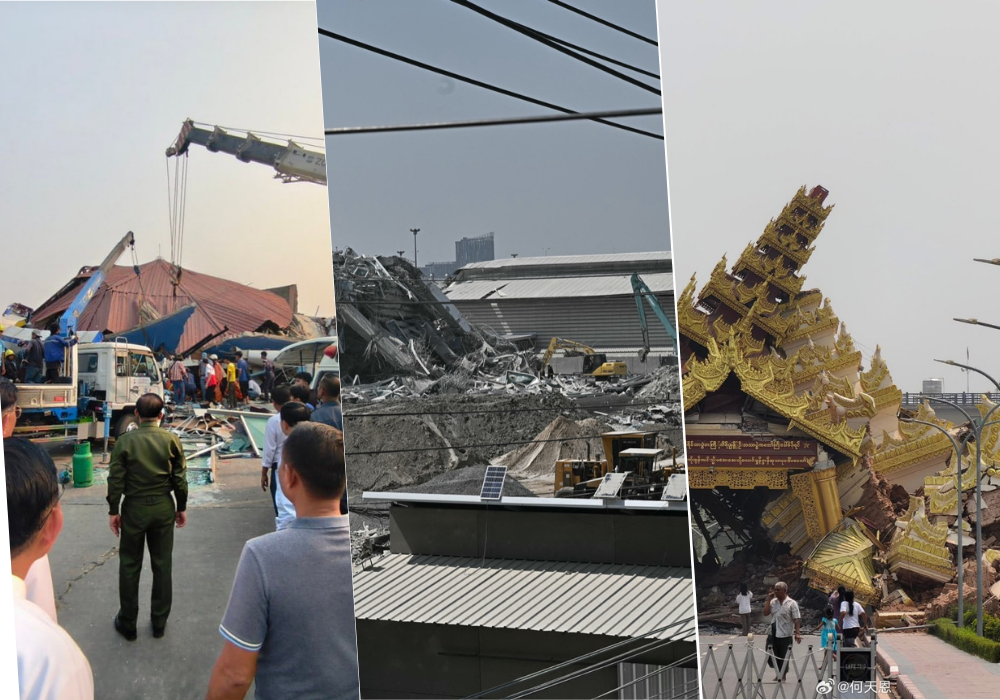A devastating 7.7-magnitude earthquake struck central Myanmar on Friday afternoon, unleashing chaos across Southeast Asia and triggering widespread destruction, including the dramatic collapse of a 30-storey skyscraper under construction in Bangkok. The powerful tremor, centered 16 kilometers northwest of Sagaing near Myanmar’s second-largest city, Mandalay, was followed just 12 minutes later by a significant 6.4-magnitude aftershock, compounding the region’s woes.
The United States Geological Survey (USGS) reported the quake occurred at a shallow depth of 10 kilometers, amplifying its destructive force.In Bangkok, the capital of neighboring Thailand, the earthquake’s violent tremors brought down a high-rise building intended for government offices, reducing it to a mangled heap of rubble and twisted metal within seconds.
Thai police and medics confirmed that at least 43 workers were trapped beneath the debris, with rescue operations underway amid desperate cries for help. “When I arrived to inspect the site, I heard people calling out, saying ‘help me,'” said Worapat Sukthai, deputy police chief of the Bang Sue district. “We estimate hundreds of people are injured, but we are still determining the number of casualties.” Footage circulating on social media captured the horrifying moment of collapse, showing clouds of dust billowing into the air as onlookers screamed and fled.
Thai Prime Minister Paetongtarn Shinawatra swiftly declared Bangkok an “emergency zone” in response to the disaster, cutting short an official visit to Phuket to convene an urgent meeting. “The Prime Minister is returning to Bangkok immediately and urges the public to avoid high-rise buildings, use stairs only, and remain calm,” read a statement from her office. Metro and light rail services in the city were suspended, stranding millions and exacerbating the chaos in the bustling metropolis of over 17 million residents. The Stock Exchange of Thailand also halted trading for the afternoon session, citing the severity of the situation.
Across the border in Myanmar, the quake’s epicenter near Sagaing—a region already strained by ongoing civil conflict—left a trail of destruction. The historic Ava Bridge, also known as the Old Sagaing Bridge, collapsed into the Irrawaddy River, severing a key connection between Mandalay and Sagaing. In Mandalay, social media posts showed collapsed buildings and streets strewn with debris, while eyewitnesses reported at least three deaths from a mosque collapse in the town of Taungoo. Myanmar’s military junta, grappling with limited resources and a fractured healthcare system, declared a state of emergency across six regions and issued a rare appeal for international aid. A major hospital in the capital, Naypyitaw, was designated a “mass casualty area,” with patients treated outdoors due to structural damage.
The earthquake’s reach extended beyond Myanmar and Thailand, with tremors felt as far as China’s Yunnan and Guangxi provinces. Beijing’s quake agency recorded the event at a magnitude of 7.9, and social media users reported strong shaking, with videos showing dust clouds rising from buildings in the border city of Ruili. Residents in northern Thailand, including Chiang Mai, described the quake as the strongest they had ever experienced. “I quickly rushed out of the shop along with other customers,” said Sai, a 76-year-old minimart worker in Chiang Mai.
Experts attribute the quake to the Sagaing Fault, a major tectonic boundary running north to south through Myanmar’s heart. “This was not an unexpected event,” said Shengji Wei, a principal investigator at the Earth Observatory of Singapore, who has studied seismic hazards in Myanmar for a decade. The country has a history of powerful quakes, with six events exceeding 7.0 magnitude between 1930 and 1956. A 6.8-magnitude quake in 2016 devastated the ancient city of Bagan, killing three and damaging its iconic temples. Myanmar’s vulnerability is heightened by rapid, often unregulated urban development and aging infrastructure, leaving its cities ill-prepared for such disasters.
Source- TRT


















